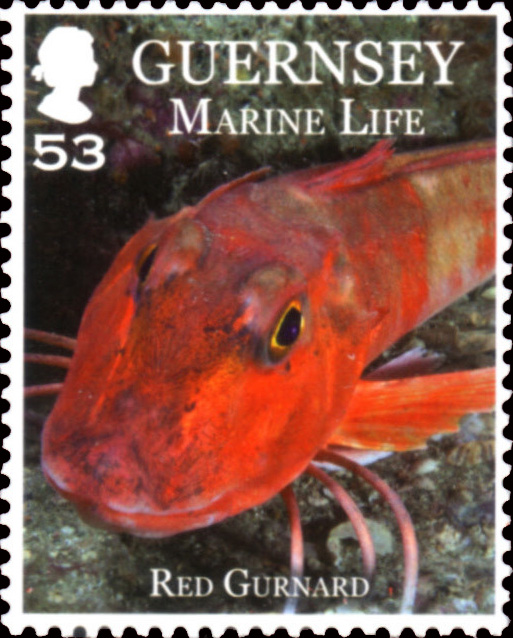Chelidonichthys kumu Cuvier, 1829

(Da: it.wikipedia.org)
Phylum: Chordata Haeckel, 1874
Subphylum: Vertebrata Lamarck J-B., 1801
Classe: Actinopterygii Klein, 1885
Ordine: Scorpaeniformes Greenwood et al., 1966
Famiglia: Triglidae Risso A., 1826
Genere: Chelidonichthys Kaup, 1873
Italiano: Gallinella australe
English: Bluefin gurnard, Pacific red gurnard
Descrizione
Molto simile a Chelidonichthys lucerna diffuso anche nei mari europei e nel mar Mediterraneo. Sebbene non abbia ghiandole velenifere pare che la puntura dei raggi spinosi della prima pinna dorsale abbia effetti dolorosi. La colorazione è olivaceo o bruno che vira verso il rosso quando il pesce è disturbato. La parte inferiore delle pinne pettorali sono cosparse di macchie nere e punti bianchi. Misura fino a 60 cm, la taglia media è sui 40 cm. Il peso massimo noto è di 1,5 kg. La carne è ottima e la specie è oggetto di pesca commerciale. Viene spesso impiegata per la produzione del surimi. Si nutre prevalentemente di crostacei.
Diffusione
Nelle aree temperate e subtropicali dell'Indo-Pacifico. È comune nelle acque dell'Africa sudorientale del Mozambico e del Sudafrica (fino al Capo di Buona Speranza) nonché dell'Australia meridionale e della Nuova Zelanda. Risulta segnalato anche in Giappone, in Corea e a Hong Kong. bentonico, vive su fondali sabbiosi e di conchiglie della piattaforma continentale.
Bibliografia
–Acero, A.; Fricke, R.; and Murdy, E. (2010). "Chelidonichthys kumu". IUCN Red List of Threatened Species. en.
–Froese, Rainer; Pauly, Daniel (eds.) (2022). "Chelidonichthys kumu" in FishBase.
–Eschmeyer, William N.; Fricke, Ron & van der Laan, Richard (eds.). "Species in the genus Chelidonichthys". Catalog of Fishes. California Academy of Sciences.
–Christopher Scharpf & Kenneth J. Lazara, eds. (10 June 2021). "Order Perciformes (Part 12): Suborder Triglioidei: Families Triglidae and Peristediidae". The ETYFish Project Fish Name Etymology Database. Christopher Scharpf and Kenneth J. Lazara.
–Eichelsheim, J. (2010). Top Catch: Hook up New Zealand’s top 12 species. Random House New Zealand, Auckland.
–Lang P. (2000). New Zealand fishes - Identification, natural history and fisheries. Reed. pp. 80-81.
–Ayling T.; Cox G.J. (1982). Collins guide to the sea fishes of New Zealand. Collins. p. 197.
–Powell A.W.B. (1947). Powell’s Native Animals of New Zealand (4 ed.). David Bateman Ltd, Auckland. p. 71.
–Francis M. (2012). Coastal fishes of New Zealand - Identification - Biology - Behaviour. Craig Potton Publishing, Nelson. p. 82.
–lder, R. D. (1976). "Studies on age, growth, reproduction and population dynamics of red gurnard, Chelidonichthys kumu, in the Hauraki Gulf". New Zealand Fisheries Research Bulletin. 12: 1-77.
–MacGibbon, D. & Hurst, R. (2017). "NIWA research vessel surveying fish in Tasman and Golden Bays".
–Roberts D.C.; Stewart A.L.; Struthers C.D. (2015). The fishes of New-Zealand (Volume 3)-Systematic Accounts. Te Papa Press. p. 1108.
–Atlas of the Living Resources of the Seas. FAO Fisheries Department, Rome. 1981.
–Lyon, W.S. & Horn, P.L. (2011). Length and age of red gurnard (Chelidonichthys kumu) from trawl surveys off west coast South Island in 2003, 2005, and 2007, with comparisons to earlier surveys in the time series (Report). New Zealand Fisheries Assessment Report 2011/46.
–Clearwater, S.J. & Pankhurst, N.W. (1994). "Reproductive Biology and Endocrinology of Female Red Gurnard, Chelidonichthys kumu (Lesson and Garnot) (Family Triglidae), from the Hauraki Gulf, New Zealand". Australian Journal of Marine and Freshwater Research. 45 (2): 131-139.
–"Red Gurnard (GUR)". Ministry for Primary Industries. 2008.
–Furukawa, I. & Ikeda, M. (1953). "Ecological studies on the bottom fish in the Hyuga Nada - I. Red Gurnard". Bulletin of the Japanese Society of Scientific Fisheries. 19: 390-397.
–Bulman C.; Althaus F.; He X.; Bax N.J.; Williams A. (2001). "Diets and trophic guilds of demersal fishes of the south-eastern Australian shelf". CSIRO Marine Freshwater Research. 52: 537-548.
–Allum L.L. & Maddigan F.W. (2012). "Unusual stability of diet of the New Zealand fur seal (Arctocephalus forsteri) at Banks Peninsula, New Zealand". New Zealand Journal of Marine Freshwater Research. 46 (1): 91-96.
–"It's good news for seals and it's good news for fishers". Department of Conservation.
–Hewitt G. C. & Hine P. M. (1972). "Checklist of parasites of New Zealand fishes and of their hosts". New Zealand Journal of Marine and Freshwater Research. 6 (1-2): 69-114.
–Lymbery A. J.; Doupé R.G.; Munshi M. A.; Wong T. (2002). "Larvae of Contracaecum sp. among inshore fish species of southwestern Australia". Diseases of Aquatic Organism. 51: 157-159.
–"Red Gurnard". Ministry for Primary Industries. 2018.
–Amorim, M. Clara (2006). "Diversity of sound production in fish". Communication in Fishes. 1: 71-105.
–Radford C.A.; Ghazali S.M.; Montgomery J.C.; Jeffs A.G. (2016). "Vocalization Repertoire of Female Bluefin Gurnard (Chelidonichthys kumu) in Captivity: Sound Structure, Context and Vocal Activity". PLOS ONE. 11 (2).

|
Data: 20/02/2013
Emissione: Vita marina Stato: Guernsey |
|---|